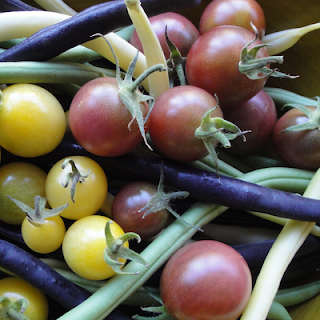I made quite a gorgeous and festive dish for the holidays by stuffing the squash with a tasty rice preparation that works very well when made ahead of time, then assembled and heated for your dinner.
Tips for Success with Stuffed Squash
The trick is to roast the squash as prepared above in the photo, before you stuff it. Carefully cut the top off to form a bowl, and score the inside. Rub lightly with olive oil or butter to keep it moist.
I baked mine at 400 F for about 30 minutes. The squash meat should be just tender - not mushy. Take care to check it while roasting so that it doesn't get too soft and collapse.
The trick is to roast the squash as prepared above in the photo, before you stuff it. Carefully cut the top off to form a bowl, and score the inside. Rub lightly with olive oil or butter to keep it moist.
I baked mine at 400 F for about 30 minutes. The squash meat should be just tender - not mushy. Take care to check it while roasting so that it doesn't get too soft and collapse.
While the squash is in the oven, a simple and versatile stuffing can be made with cooked rice (I used brown rice mixed with wild rice) flavored with sauteed onions, celery, herbs, (thyme, rosemary) and mushrooms. Saute the onions and additions separately then mix with the rice in a bowl. Adding chopped nuts such as pecans or walnuts and a handful of raisins creates a tasty dish appropriate for holidays celebrations.
Spoon the mixture into your partially baked squash, then return to the oven at about 350 F for 30 minutes to heat it thoroughly before serving.
Spoon the mixture into your partially baked squash, then return to the oven at about 350 F for 30 minutes to heat it thoroughly before serving.
Growing Winter Squashes
A beautiful harvest of Stella Blue Hokkaido, pictured below. Squashes are easy to start from seed, and by growing your own you'll have the best choice of heirloom varieties.
Although direct planting into a prepared mound is often recommended (with good compost or organic fertilizer), I've had success starting my seeds in containers and transplanting the seedlings after they have developed leaves and are about four inches high.
Plant in spring as soon as the temperatures at night are in the 50's F and the soil has warmed, so that you get as much warm weather growing time as possible. They like regular water and grow quickly with a sprawling habit, so give them room on the ground or let them climb up a trellis. If you let them climb, you'll have to provide support when the squashes develop so they don't fall off!
Check Seed Saver's Exchange and Seeds of Change for seeds.
 |
| The beautiful Stella Blue Hokkaido squash is my favorite |
Photos: Patricia Larenas, Urban Artichoke















































